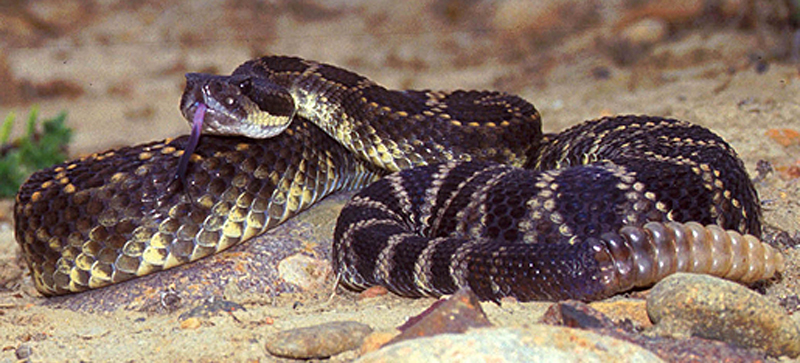The days are getting warmer, and the rattlesnakes are being seen in our valley. The climate and the food supply are adequate, so they are here to stay.
Rattlesnakes are feared – but by learning a few facts about them, you should be able to respect them and even appreciate them for the wonderful creatures they are.
Remember also that they are useful, as they kill many rodents.
Every time a rattlesnake sheds it skin, it adds a new section to its rattler. For this reason, some people say you can tell the age of a rattlesnake by the number of sections in its rattler. But the sections often break off, so you really cannot use them to tell age.
A rattlesnake can strike prey that is very close to its head from almost any position. But to strike an animal that is more than a few inches away, it throws the front half of its body forward, then sinks its fangs into the prey.
The fangs of rattlesnakes are hollow. They have sharp, pointed tips that can break through skin.
Venom is pushed through the hollow fangs into the prey. The amount of venom injected depends on the size of the prey. In general, a rattlesnake will use less venom for smaller prey and more for larger prey.
The fangs of a rattlesnake are usually folded inside the mouth. The fangs move forward when the snake strikes, and the snake begins to inject the venom.
In general, a rattlesnake can strike out for a distance of half of its body length. However, a rattlesnake that is up on a ledge may be able to strike farther.
How they hunt
All rattlesnakes are pit vipers. That means that they have special openings called pits on their faces that can feel heat. Even in complete darkness, the pits can “see” the heat given off by the bodies of warm-blooded animals.
To smell, a rattlesnake uses its tongue. The moist tongue is flicked out to pick up smells from the air and ground. The tongue carries the smell into the mouth, where it is “tasted” by a special structure called Jacobson’s organ.
The ears of a rattlesnake are inside the head; there no ear openings on the outside.
Different senses are used to find prey at different distances. When an animal is far away, the snake can hear the vibration though its jaw bones when resting on the ground. At close range, the snake can use its tongue or its pits.
They can see short distances, up to 15 feet. They have large eyes with pupils that can open very wide so they can see in the dim light. They do not have eye lids.
When they hunt, rattlesnakes move slowly and carefully or may wait in one spot for prey to come along. They poke their heads into holes using their tongue and pits to see if warm animals are inside. When they strike, they lunge forward at a speed of 10 feet per second.
Snakes must swallow their prey whole. They use the muscles in their necks to pull the food down into the stomach. This is a slow process, and it may take hours for a snake to finish swallowing a meal.
How to behave
If you see a rattlesnake on the trail, freeze in your tracks and move away slowly without turning your back. Do not chase after it or do anything that might get the snake excited.
Parents, always walk first on the trail. You will see the snake first and will be able to make the right move.
Bear in mind that the snake does not want to bite you. You are not prey.
Never try to kill the snake, as it’s often the time you will get bitten.
Dog owners, you know your dog should be on a leash on the trail. If you live in an area with many rattlesnakes, be aware there is a vaccine that can be given to your dog before disaster happens.
Always look where you put your hands. Do not reach into holes or dark places where a rattler could be hiding.
Never pick up a snake, even if it looks dead. It might just be pretending to be.
Try to stay off of tall grasses, but be careful if you have to walk through them.
If you are bitten by a rattlesnake, have somebody else drive you to the hospital to prevent your blood from pumping faster and allowing the venom to spread. Hospitals are well equipped to deal with this emergency, especially in our area.
This article originally appeared in the March-April 2012 edition of The Rattler, the newsletter of the Placerita Canyon Nature Center Associates. The Nature Center is located at 19152 Placerita Canyon Rd, Newhall. For information or to volunteer, visit www.Placerita.org. Join the PCNCA Facebook group here: http://www.facebook.com/groups/pcnca.
Like this:
Like Loading...
Related





 Tweet This
Tweet This Facebook
Facebook Digg This
Digg This Bookmark
Bookmark Stumble
Stumble RSS
RSS




























REAL NAMES ONLY: All posters must use their real individual or business name. This applies equally to Twitter account holders who use a nickname.
0 Comments
You can be the first one to leave a comment.